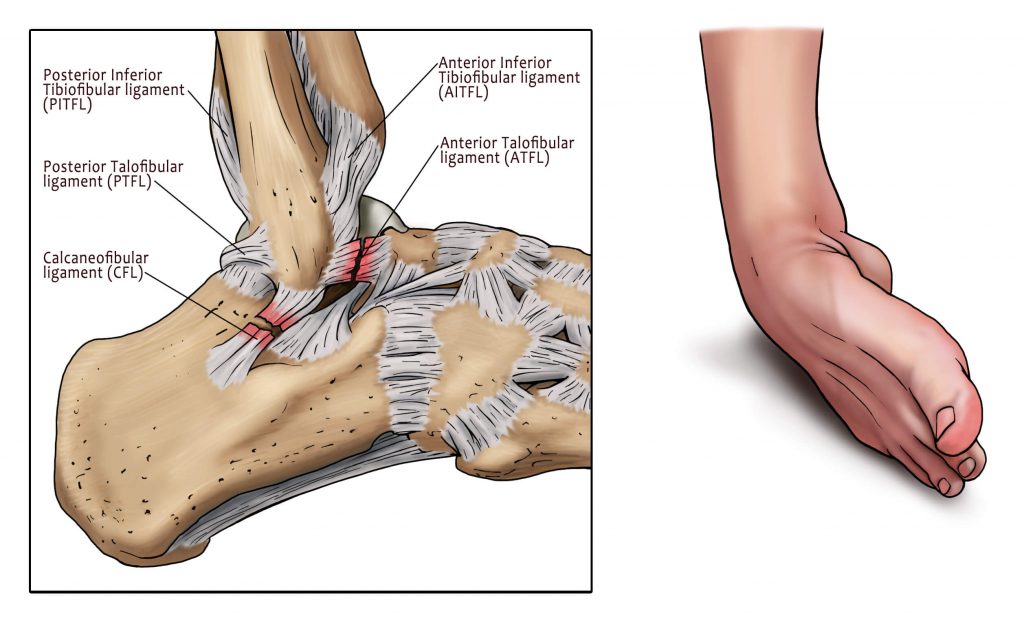 More than one million people a year visit the emergency room with a severe ankle sprain. . Millions more will sprain their ankle but never seek help.
More than one million people a year visit the emergency room with a severe ankle sprain. . Millions more will sprain their ankle but never seek help.
What can I do if I have rolled my ankle?
So you have rolled or sprained your ankle, you have ankle swelling and foot pain and you cannot weight bear. What do you do? In this article we will cover what is an ankle sprain? When should I go to A&E? Should I use ice or heat? Should I use an ankle brace? and what exercises can I do?
What is an ankle sprain?
The ligaments of the ankle hold the ankle bones and joints in position. Ligaments protect the ankle joint from abnormal movements such as twisting, turning, and rolling of the foot. Ligaments are elastic like an elastic band so they stretch and return to their normal shape. If they stretch more than they are allowed then they can tear which is known as a sprain. Initially a few fibres tear (a grade1 injury). Then a few more fibres tear (a grade 2 injury) and finally the two ends snap apart (a grade 3 injury). Clearly a grade 3 injury is the most severe.
How do you get a sprained ankle?

There are several ligaments that stabilize the outside of the ankle which are demonstrated in the above illustration. The two most commonly injured ligaments are on the outside of the ankle. These are known as the ATFL (anterior talo-fibular ligament) and the CFL (calcaneofibular ligament).
The deltoid ligament is one broad ligament on the inside of the ankle. This may be injured in a severely sprained ankle and in ankle fractures. There is also a ligament complex securing the tibia and fibula together called the syndesmosis. Sometimes referred to as “high ankle sprain”, this may be injured during severe ankle sprains (or fractures). Injuries to the ligaments can be mild tears (grade I), moderate tears (grade II) to completely torn (grade III).
These ligaments all relate to the upper ankle joint between the tibia, fibula, and talus. In addition, there is a joint below the talus called the subtalar joint which also has strong ligaments. It is almost impossible to sprain an ankle without also spraining the subtalar joint ligaments but rarely are these injuries reported on MRI scans.
Why do I have swollen ankles?
Swollen ankles result from inflammation and gravity. When you tear a ligament small blood vessels also tear and it bleeds and creates an inflammatory reaction, the cardinal signs of which includes heat, redness, and swelling. Gravity is not on your side and so the swelling pools in your ankles and feet and so you can have foot pain, bruising and swelling as well.
When should I seek medical help for sprained ankle treatment?
If your ankle is very swollen or bruised or you are struggling to weight bear you are advised to seek a medical opinion from a healthcare professional. They will take a medical history, examine you and may perform an X-ray. Even if the X-ray is normal, it is sometimes quite difficult to rule out a severe grade 3 ligament injury and if it is very swollen then you are recommended to rest the foot in an ankle brace or Walker Boot. For a grade 1 sprain this may only be for a few days. For a grade 2 sprain perhaps up to 2 weeks and for a grade 3 sprain you are recommended to use an ankle brace for 4-6 weeks.
What emergency treatment can I do?
The treatment for an acute injury is an acronym known as RICE. This stands for REST, ICE, COMPRESSION, & ELEVATION. Rest the ankle, why because after any injury an inflammatory response is developed which causes swelling and pain and requires a period of rest for a few days. I stands for ICE and you should apply cold to reduce the swelling and inflammation. There is some controversy on the Internet about harmful effects of ice. This is flawed science. Ice is important in the first few days to help settle the swelling and pain but does not stop the healing. You should apply ice using a cold compress for about 20 minutes but be cautious to avoid an ice burn so you may wish to apply some oil to the skin or a pillow case cover to prevent direct contact with the skin. You can apply 20 minutes on and 10 minutes off repeatedly in the first few hours. You will be amazed at how much the swelling will reduce. This is aided by C for compression – apply a compression bandage like an ACE bandage or a Tubigrip and finally E for elevate. Why? Well because gravity is not on your side and the swelling pools in your legs. If you elevate the foot to heart level it will swell much less.
When should I use an ankle brace?
An ankle brace is an excellent way to support the ankle ligaments to keep them in an anatomical position whilst they heal. If they heal anatomically then you should do well. If they heal stretched or lengthened then this can lead to subtle ankle instability which could cause problems down the line. By down the line, I mean it could take 20-30 years before you realise your ankle had some subtle instability and the shock absorbing cartilage can wear away. Contrary to popular myth, ankle braces with struts on either side do not limit up an down motion they simply stop the side to side motion which is unhealthy whilst the ligaments are healing. In addition ankle braces do not cause your muscles to be weak. If they did then Tennis superstar Andy Murray wouldn’t wear an Aircast A60 on both ankles for every game he plays. His function is amazing and not limited because of his use of ankle braces. I recommend that for a grade 2 ankle sprain you wear a brace for a couple of weeks and for a grade 3 ankle brace for longer perhaps 4-6 weeks. Good ankle brace options include: the Aircast A60 or Aircast AirSport ankle braces; the or the Bauerfeind MalleoLoc Ankle Support or the VacoTalus from OPED. All of these have side struts to prevent side to side motion.
What is a high ankle sprain?
A high ankle sprain is also known as a syndesmotic injury. The ankle syndesmosis is the joint between the tibia and the fibula bones and they are joined together by strong ligaments. One at the front called the Anterior Inferior Tibiofibular ligament (AITFL) and one at the back called the Posterior Inferior Tibiofibula Ligament (PITFL). In the centre is the ankle syndesmosis which is a flat band of connective tissue that is very stable. During normal ankle motion there is a small amount of movement of the fibula relative to the tibia. This allows the talus bone to fit in the ankle mortice as the front of the talus is wider than the back of the talus and so when the foot is brought upwards the fibula moves sideways and rotates slightly to accommodate it. In a severe or high ankle sprain, the ligaments of the ankle syndesmosis are also injured. In a severe injury all three ligaments are torn and there is instability of the ankle. A severe injury usually will require surgical fixation, but most milder injuries do not need surgery but they do need a longer period of immobilisation because they can take double the time of a standard ankle ligament injury to heal. If a diagnosis is suspected of a high ankle sprain, you are recommended to see a specialist as soon as possible.
What do I do if I have ankle pain 4-5 weeks after a sprain ?
If its 4-5 weeks after your ankle sprain and your ankle doesn’t seem to be getting better it is worth seeking expert advice to make sure another type of injury has not been missed. Other injuries associated with ankle sprains include a broken ankle, also known as a fractured ankle, that may not have been seen, a fracture of the 5th metatarsal, Talar body fractures, subtalar joint injuries, peroneal tendon issues, and cartilage and bone injuries (osteochondral lesions of the talus).
Sprained ankle treatments – what exercises can I do?
Its really important for you to do exercises after an ankle sprain.
This video shows exercises that you can do after an acute ankle sprain where we interviewed 6 leading physiotherapists including Tony Betts from the Royal National Orthopaedic Hospital, Jess Rider from Body Balance Physiotherapy, Chris Myers from Complete Physio, Harinee Ohri from Third Space Soho, Matt Todman from Six Physio, and Sam Wilde from Pure Sports Medicine. Exercises including loading, alphabet, and balance work are ideal for the first few days and once the swelling has reduced and weight bearing is not painful then more demanding exercises like heel raises and single leg balance work as well as hops, twists and jumps can be instituted to get back to peak performance.
QUESTIONS TO ASK YOUR DOCTOR IF YOU HAVE SPRAINED YOUR ANKLE.
- Is it broken?
- Do I need any special tests?
- How long will it take for this to get better?
- What’s the best treatment plan for me?
- Are there any alternatives to what you are suggesting?
- Is there anything I need to avoid?
- Do you recommend any patient information guides or websites for more information?
Did you enjoy this article? You may also like What is Plantar Fasciitis? (Heel Pain)
London ankle sprain
